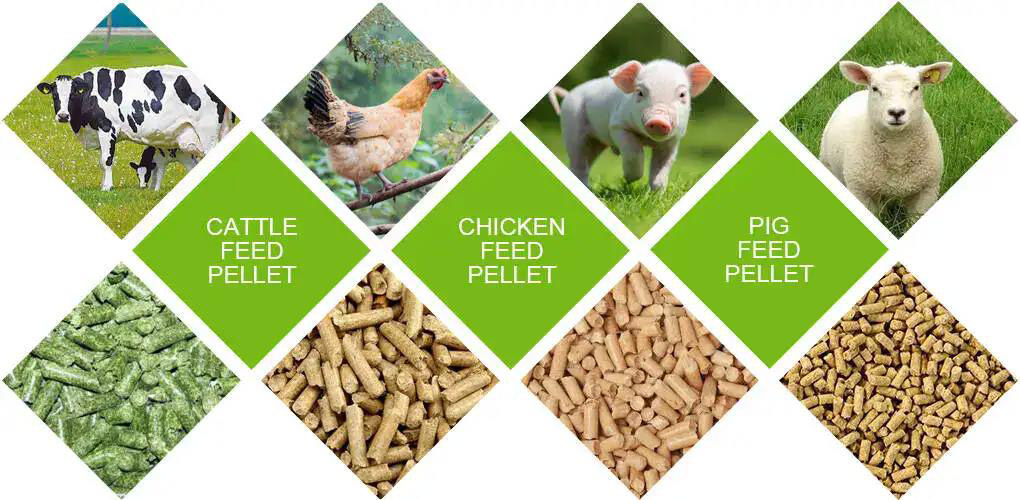large feed machine
A large feed machine is a piece of equipment specifically designed for industrial-level or large-scale farming operations, used to process and produce large quantities of animal feed.
large feed machine Introduction
A large feed machine is a piece of equipment specifically designed for industrial-level or large-scale farming operations, used to process and produce large quantities of animal feed. These machines are typically larger in size and have greater processing capabilities compared to small feed machines. They can handle and process large volumes of raw materials such as various grains, soybean meal, fish meal, etc. Operating a large feed machine usually requires specialized technical expertise and meets the extensive animal feeding requirements for poultry, livestock, aquaculture, and pets.


Main features of large feed machine
High processing capacity
Capable of handling large quantities of raw materials such as various grains, soybean meal, fish meal, etc., to meet the feed demands of large-scale farming operations.
Specialized design
Typically designed with more complexity and specialization to meet the requirements and challenges of large-scale production environments.
High level of automation
Equipped with advanced control systems and automated equipment to enhance production efficiency and accuracy.
Versatility
Can perform multiple processing operations such as grinding, mixing, pelleting, etc., to meet the feeding requirements of different animal species.
Durability
Built with sturdy construction to withstand long-term operation and high-intensity workloads.
Parts and maintenance
Includes specialized parts and maintenance facilities to ensure equipment reliability and long-term operation.
Cost-effectiveness
Despite higher initial investment, it significantly reduces the cost per unit of feed production in large-scale production.
Environmental friendliness
Designed to meet environmental standards, effectively managing waste and emissions.


Main structure of large feed machine
Feeding system
Introduces various raw materials (such as grains, soybean meal, fish meal, etc.) into the machine for processing.
Crushing system
Includes crushers or grinders if raw materials need to be crushed or pulverized.
Mixing system
Blends different types of raw materials in specified proportions to ensure the balanced nutrition of the final feed.
Pelleting system
Shapes the mixed feed ingredients into pellets for ease of storage, transportation, and consumption.
Processing control system
Incorporates advanced operating panels and control devices to regulate and monitor various stages of the processing process, ensuring feed quality and processing efficiency.
Electric motor or power system
Provides the driving force to operate the machine, typically utilizing electric motors or other power sources.
Discharge system
Removes processed feed from the machine, ready for animal feeding.
Frame and supports
Provides structural framework to support and secure the components of the machine, ensuring stability and safe operation.


Main advantages of large feed machine
High processing capacity
It can handle large volumes of raw materials, meeting the feed demands of large-scale farming operations and improving production efficiency.
Versatility
Capable of performing various processing operations such as crushing, mixing, pelleting, etc., catering to the feeding requirements of different animal types.
Precise feed formulation control
Equipped with advanced control systems, it can accurately adjust feed ingredients and ratios to ensure feed quality and nutritional balance.
Cost savings
Despite higher initial investment, processing feed independently can significantly reduce the cost per unit of feed production, offering long-term cost-effectiveness.
Increased production efficiency
Automated and efficient processing ensures timely supply of high-quality feed, enhancing farming efficiency and animal health.
Durability
Built with sturdy construction, it can operate stably for extended periods under high-intensity conditions.
Environmental sustainability
Designed to meet environmental standards, it effectively manages waste and emissions, minimizing environmental impact.
Flexibility and customization
Can be customized and adjusted according to specific farm requirements, accommodating the feeding needs of different animal species and growth stages.
Application of sheep feed machine
Typically, the production of feed machine uses raw materials such as corn, soybeans, wheat, and other nutrients as the formula. Our pellet feed machine are specially used to produce feed for poultry, livestock, pigs, horses, cattle, sheep, chickens, ducks, goose and other animals.For different animals, with different growth cycles, (chicks, suckling pigs, calves, etc.), the feed pellet size required is different, but our feed production line only needs to replace ring molds with different apertures or use a pellet crumbler to reach the required size.

Parameter of sheep feed machine
| Model | Capacity | Main Motor Power | Feeder Motor Power | Conditioner Power | Dia. of Ring Die | Pellet Size |
| SZLH250 | 1-2T/H | 22KW | 0.75kw | 1.5kw | 250mm | 2-12mm |
| SZLH320 | 3-4T/H | 37KW | 1.5kw | 2.2kw | 320mm | 2-12mm |
| SZLH350 | 5-7T/H | 55KW | 1.5kw | 3kw | 350mm | 2-12mm |
| SZLH420 | 8-12T/H | 110KW | 1.5kw | 7.5kw | 420mm | 2-12mm |
| SZLH508 | 10-18T/H | 160KW | 2.2kw | 11kw | 508mm | 2-12mm |
| SZLH558 | 15-25T/H | 180KW | 2.2kw | 11kw | 558mm | 2-12mm |
| SZLH678 | 20-30T/H | 220KW | 2.2kw | 11kw | 678mm | 2-12mm |
| SZLH768 | 25-42T/H | 280KW | 2.2kw | 11kw | 768mm | 2-12mm |








